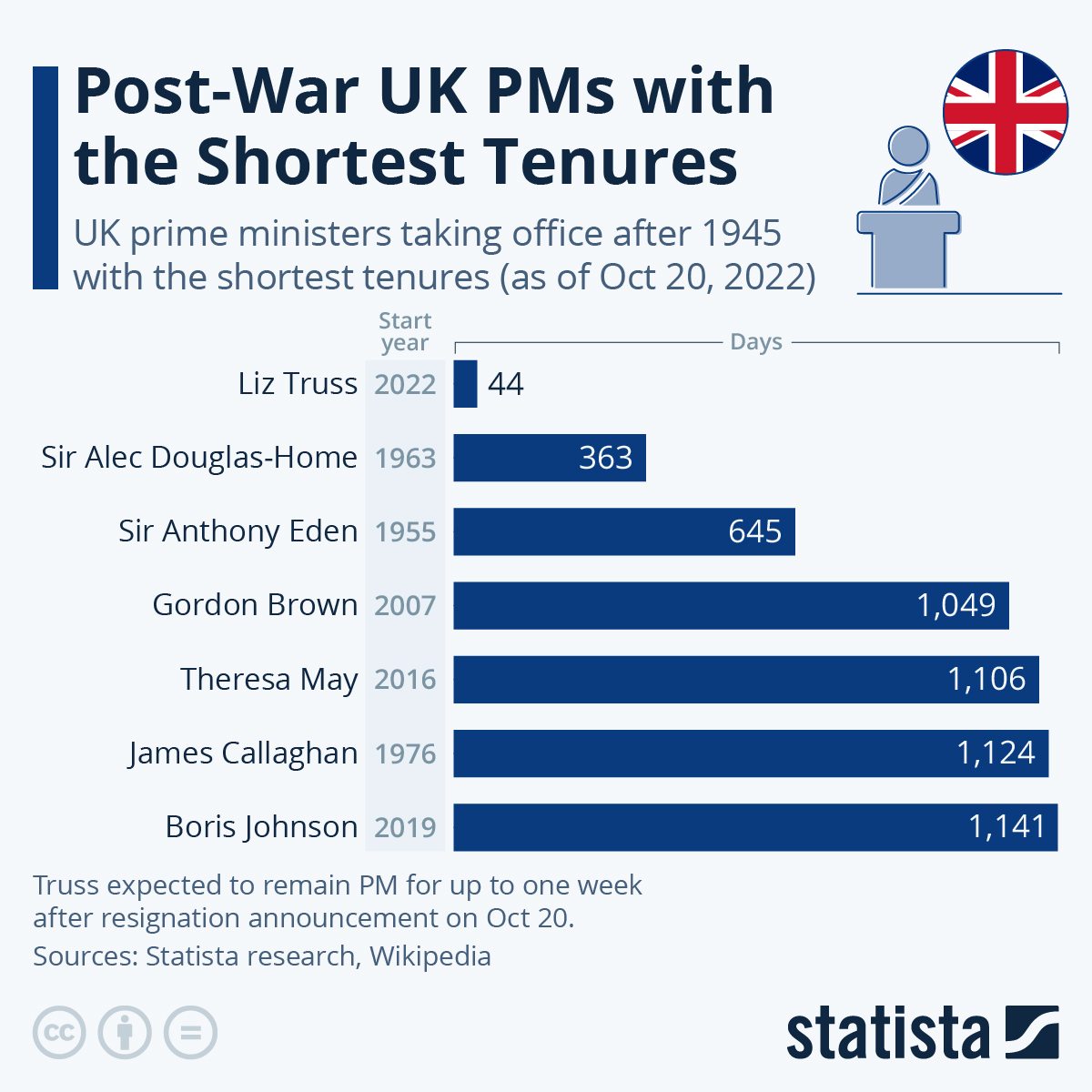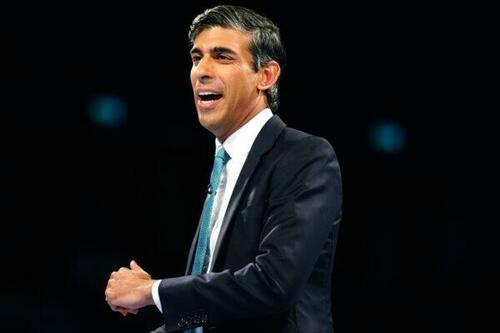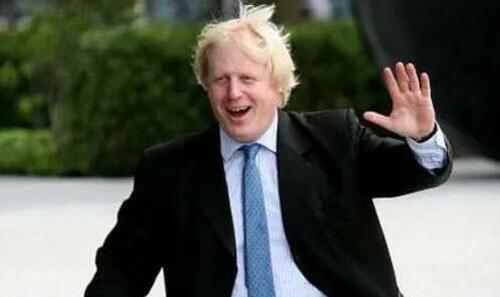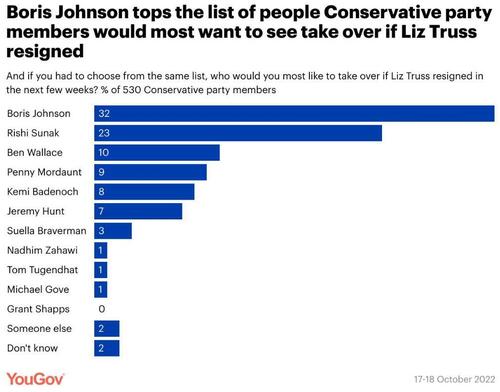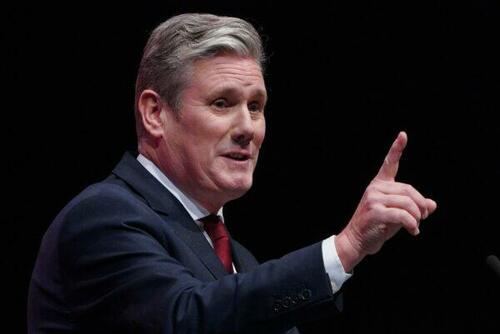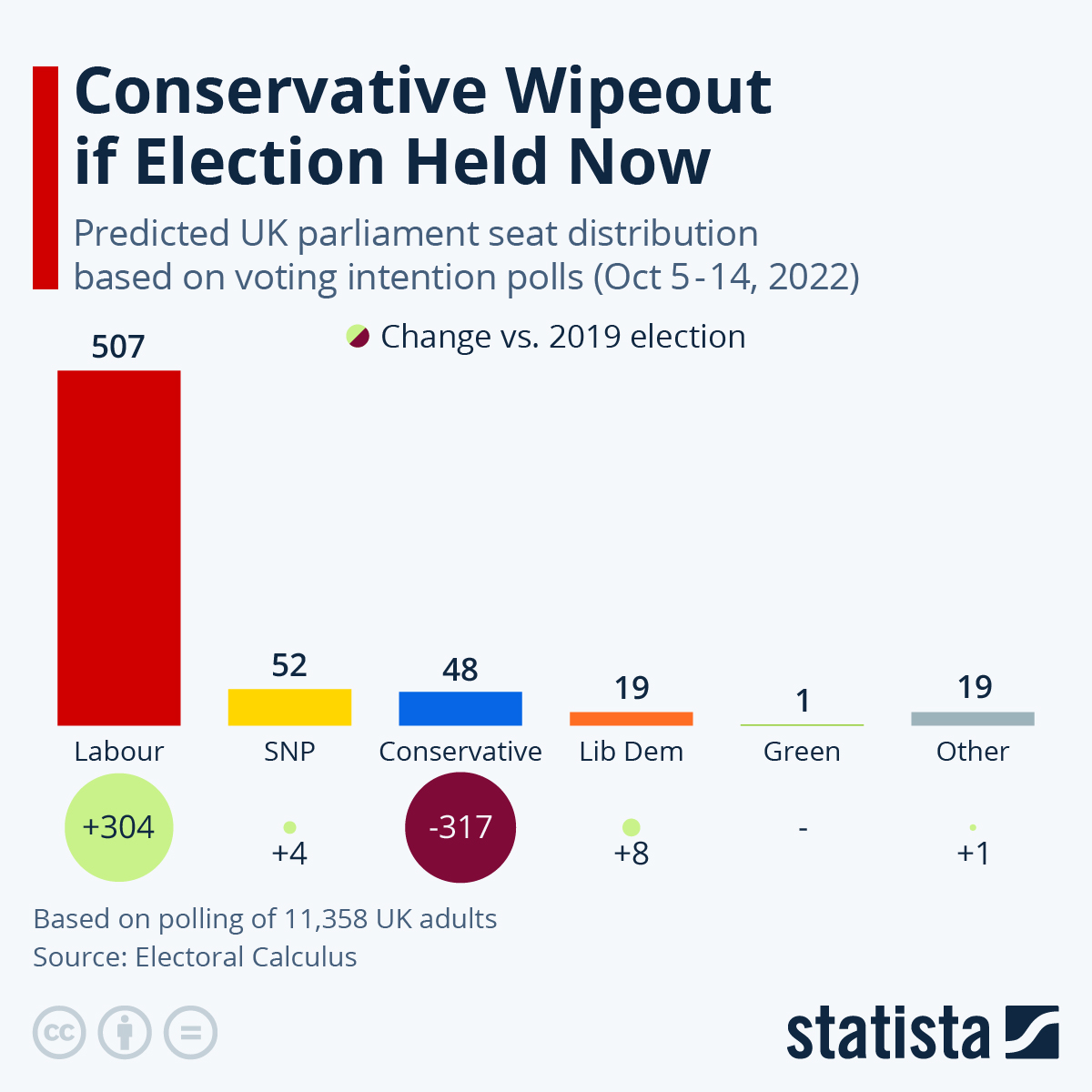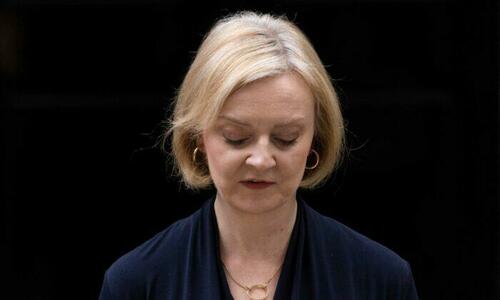
Authored by Katabella Roberts via The Epoch Times,
Following UK Prime Minister Liz Truss’s shock resignation on Thursday after just six weeks in office, the race is now on to find her successor, and it could happen by as early as next week.
Truss, 47, announced she was stepping down in a lengthy speech outside the prime minister’s official residence at Number 10 Downing Street in which she acknowledged, “Given the situation, I cannot deliver the mandate on which I was elected by the Conservative Party.”
Her departure came amid mounting public pressure following backlash and market carnage owing to her and then-Chancellor Kwasi Kwarteng’s so-called “mini-budget” which was unveiled earlier in September.
The plan to “jump-start the economy,” which featured huge tax cuts worth £45 billion ($50 billion) funded by large amounts of government borrowing, ultimately jump-started market chaos and a tumultuous few weeks for Truss.
The economic package also saw a number of Conservative MPs lose confidence in her leadership.
Just one day prior to her registration, Truss had remained defiant that she was not a “quitter.”
However, her short tenure in office has seen Truss take a number of u-turns, including later scrapping almost all of the proposals laid out in her “mini-budget”.
You will find more infographics at Statista
How Do Tory Leadership Elections Work?
Following Truss’s announcement, there will now be another leadership election to decide who becomes the next Conservative leader and prime minister, with her replacement expected to be announced by the end of next week.
Under party rules, candidates will need to secure at least 100 nominations from fellow Tory MPs to join the race or enter the ballot, which will likely take place on Monday.
Given that there are only 357 Tory MPs, a maximum of three candidates will make it to the first stage, although it is more likely that only two candidates will make it through the first stage. However, there is also a chance that one winner will be declared on Monday.
Rishi Sunak
Potential candidates currently include Rishi Sunak, who served as chancellor of the Exchequer from February 2020 to July 2022 and ran to replace former Prime Minister Boris Johnson as leader earlier this summer, after the latter resigned.
Rishi Sunak during a hustings event in Cheltenham, England, as part of the campaign to be leader of the Conservative Party and the next prime minister, on Aug. 11, 2022. (Ben Birchall/PA Media)
Sunak, who narrowly lost out on the role to Truss after failing to secure enough support from Conservative Party members, had warned that her tax plans could cause chaos to the UK economy.
While Sunak is a hot favorite to become the next prime minister, his elite background and controversy over his wife’s tax affairs, along with a fine he received for breaching lockdown rules, may not sway in his favour.
Penny Mordaunt
Elsewhere, the leader of the House of Commons, Penny Mordaunt, is another favourite to replace Truss. Mordaunt, 49, already experienced what it’s like to be the country’s leader earlier this week when she was forced to stand in for Truss, who failed to turn up for questioning by MPs in Parliament.
Conservative Party leadership contender Penny Mordaunt at Here East studios in Stratford, east London, on July 15, 2022. (Victoria Jones/PA Media)
Mordaunt also previously ran in the last content to replace Johnson but ultimately failed to make it into the final two. Mordaunt made history in 2019 when she became the UK’s first female defence secretary, however, she is relatively unknown in Britain, which may pose a risk to her attempt to run for prime minister.
Ben Wallace
British defense secretary Ben Wallace is also in with a shot and has large support from many in the Conservative Party thanks in part to his response to Russia’s invasion of Ukraine, which saw the UK decide early on to provide weapons and training to Kyiv.
Wallace, who previously voted for the UK to remain in the EU, has served as a soldier in the British army. However, he has said he has no interest in becoming the next prime minister.
Boris Johnson Could Make a Comeback
Finally, former Prime Minister Boris Johnson, who served in the role from 2019 to 2022, is also rumoured to be in with a chance. That is despite huge public opposition for the former leader amid multiple scandals during his time in office, including a breach of the COVID-19 lockdown rules he put in place and illegal Downing Street parties, widely known as “partygate.”
While public support for Johnson is not high, the former prime minister, who has been holidaying in the Caribbean for almost all of Truss’s tenure, remains popular with Conservative Party members, according to polls.
Labour Party Calls for Early Election
Yet while the Conservative Party will be hoping to avoid calling a general election ahead of 2025, when the next UK-wide election is set to take place, the opposition Labour Party has been demanding an early one.
Opposition leader Sir Keir Starmer on Thursday renewed calls for an early election, saying in a statement that the Tories “cannot respond to their latest shambles by yet again simply clicking their fingers and shuffling the people at the top without the consent of the British people.”
Labour Party leader Sir Keir Starmer making his keynote address during the Labour Party Conference at the ACC Liverpool on Sept. 27, 2022. (Peter Byrne/PA Media)
As this infographic using Electoral Calculus data shows, Labour could gain around 304 seats if an election were to be held now, having secured over 50 percent of the votes. The Tories on the other hand would suffer a loss of 317 that would see them slip below the SNP as the second largest party.
You will find more infographics at Statista
Meanwhile, as the race for the next British prime minister is well underway, Truss has said she will remain in the role until her successor is chosen.
Authored by Katabella Roberts via The Epoch Times,
Following UK Prime Minister Liz Truss’s shock resignation on Thursday after just six weeks in office, the race is now on to find her successor, and it could happen by as early as next week.
Truss, 47, announced she was stepping down in a lengthy speech outside the prime minister’s official residence at Number 10 Downing Street in which she acknowledged, “Given the situation, I cannot deliver the mandate on which I was elected by the Conservative Party.”
Her departure came amid mounting public pressure following backlash and market carnage owing to her and then-Chancellor Kwasi Kwarteng’s so-called “mini-budget” which was unveiled earlier in September.
The plan to “jump-start the economy,” which featured huge tax cuts worth £45 billion ($50 billion) funded by large amounts of government borrowing, ultimately jump-started market chaos and a tumultuous few weeks for Truss.
The economic package also saw a number of Conservative MPs lose confidence in her leadership.
Just one day prior to her registration, Truss had remained defiant that she was not a “quitter.”
However, her short tenure in office has seen Truss take a number of u-turns, including later scrapping almost all of the proposals laid out in her “mini-budget”.
You will find more infographics at Statista
How Do Tory Leadership Elections Work?
Following Truss’s announcement, there will now be another leadership election to decide who becomes the next Conservative leader and prime minister, with her replacement expected to be announced by the end of next week.
Under party rules, candidates will need to secure at least 100 nominations from fellow Tory MPs to join the race or enter the ballot, which will likely take place on Monday.
Given that there are only 357 Tory MPs, a maximum of three candidates will make it to the first stage, although it is more likely that only two candidates will make it through the first stage. However, there is also a chance that one winner will be declared on Monday.
Rishi Sunak
Potential candidates currently include Rishi Sunak, who served as chancellor of the Exchequer from February 2020 to July 2022 and ran to replace former Prime Minister Boris Johnson as leader earlier this summer, after the latter resigned.
Rishi Sunak during a hustings event in Cheltenham, England, as part of the campaign to be leader of the Conservative Party and the next prime minister, on Aug. 11, 2022. (Ben Birchall/PA Media)
Sunak, who narrowly lost out on the role to Truss after failing to secure enough support from Conservative Party members, had warned that her tax plans could cause chaos to the UK economy.
While Sunak is a hot favorite to become the next prime minister, his elite background and controversy over his wife’s tax affairs, along with a fine he received for breaching lockdown rules, may not sway in his favour.
Penny Mordaunt
Elsewhere, the leader of the House of Commons, Penny Mordaunt, is another favourite to replace Truss. Mordaunt, 49, already experienced what it’s like to be the country’s leader earlier this week when she was forced to stand in for Truss, who failed to turn up for questioning by MPs in Parliament.
Conservative Party leadership contender Penny Mordaunt at Here East studios in Stratford, east London, on July 15, 2022. (Victoria Jones/PA Media)
Mordaunt also previously ran in the last content to replace Johnson but ultimately failed to make it into the final two. Mordaunt made history in 2019 when she became the UK’s first female defence secretary, however, she is relatively unknown in Britain, which may pose a risk to her attempt to run for prime minister.
Ben Wallace
British defense secretary Ben Wallace is also in with a shot and has large support from many in the Conservative Party thanks in part to his response to Russia’s invasion of Ukraine, which saw the UK decide early on to provide weapons and training to Kyiv.
Wallace, who previously voted for the UK to remain in the EU, has served as a soldier in the British army. However, he has said he has no interest in becoming the next prime minister.
Boris Johnson Could Make a Comeback
Finally, former Prime Minister Boris Johnson, who served in the role from 2019 to 2022, is also rumoured to be in with a chance. That is despite huge public opposition for the former leader amid multiple scandals during his time in office, including a breach of the COVID-19 lockdown rules he put in place and illegal Downing Street parties, widely known as “partygate.”
While public support for Johnson is not high, the former prime minister, who has been holidaying in the Caribbean for almost all of Truss’s tenure, remains popular with Conservative Party members, according to polls.
Labour Party Calls for Early Election
Yet while the Conservative Party will be hoping to avoid calling a general election ahead of 2025, when the next UK-wide election is set to take place, the opposition Labour Party has been demanding an early one.
Opposition leader Sir Keir Starmer on Thursday renewed calls for an early election, saying in a statement that the Tories “cannot respond to their latest shambles by yet again simply clicking their fingers and shuffling the people at the top without the consent of the British people.”
Labour Party leader Sir Keir Starmer making his keynote address during the Labour Party Conference at the ACC Liverpool on Sept. 27, 2022. (Peter Byrne/PA Media)
As this infographic using Electoral Calculus data shows, Labour could gain around 304 seats if an election were to be held now, having secured over 50 percent of the votes. The Tories on the other hand would suffer a loss of 317 that would see them slip below the SNP as the second largest party.
You will find more infographics at Statista
Meanwhile, as the race for the next British prime minister is well underway, Truss has said she will remain in the role until her successor is chosen.
